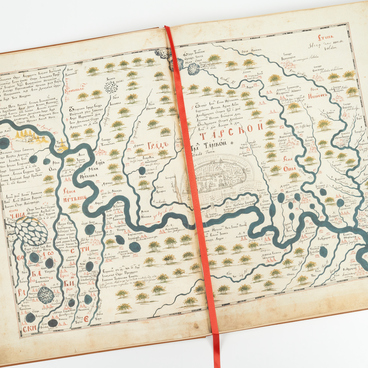The name comes from the French word ‘bureau’ which means ‘writing desk’. It was a writing desk with shelves and drawers located above the tabletop, and with a lid that covered the working area. A portable, travel version of this desk was introduced in the 18th century. The collection of the Yershov Museum Complex of Ishim City contains a travel writing desk of the mid-19th century.
This accessory was made by analogy with a chest, while the lid was designed to be slightly inclined for convenient writing. The writing desk was pasted with green woven felt from the inside and was painted and varnished from the outside. The lid had metal hinges, and a small lock was cut into the wall of the chest from the front side. It was possible to carry paper, pens, pencils, an ink-well and important documents inside the desk.
Expensive travel writing desks for the nobility were decorated with elements of precious wood: palisander, rosewood, or purpleheart. The surface was covered with ornaments in the marquetry technique. Marquetry was the name for the art of wooden mosaic, but here, in addition to wood, other materials could be used: ivory, walrus tusk, turtle shells, mother of pearl, tin, and brass inserts.
There is a removable pencil case with a pull-out panel for quills in the travel writing desk displayed in the collection of the Yershov Museum Complex of Ishim City.
The prototype of the travel writing desk was a headrest trunk.
During the traveling, in addition to being used for writing purposes, the trunk served also as a support for the pillow, and that is how it got this name. As a rule, such trunks were made of wood, covered with wrought iron at the corners and ties, fastened with metal brackets. They were small. The lid consisted of two parts: the horizontal part covered the back compartment of the trunk, and the inclined one covered the front compartment. A pillow was placed on the inclined part.
Usually merchants and clerks traveled with such trunks. They constantly traveled on state affairs with valuables and papers, which were safely hidden in a trunk at nighttime. Often, several compartments were made in these accessories for convenience: there were secret drawers protected by locks.
In the house, the headrest trunks were used as a bench and as a storage for clothes and food.
This accessory was made by analogy with a chest, while the lid was designed to be slightly inclined for convenient writing. The writing desk was pasted with green woven felt from the inside and was painted and varnished from the outside. The lid had metal hinges, and a small lock was cut into the wall of the chest from the front side. It was possible to carry paper, pens, pencils, an ink-well and important documents inside the desk.
Expensive travel writing desks for the nobility were decorated with elements of precious wood: palisander, rosewood, or purpleheart. The surface was covered with ornaments in the marquetry technique. Marquetry was the name for the art of wooden mosaic, but here, in addition to wood, other materials could be used: ivory, walrus tusk, turtle shells, mother of pearl, tin, and brass inserts.
There is a removable pencil case with a pull-out panel for quills in the travel writing desk displayed in the collection of the Yershov Museum Complex of Ishim City.
The prototype of the travel writing desk was a headrest trunk.
During the traveling, in addition to being used for writing purposes, the trunk served also as a support for the pillow, and that is how it got this name. As a rule, such trunks were made of wood, covered with wrought iron at the corners and ties, fastened with metal brackets. They were small. The lid consisted of two parts: the horizontal part covered the back compartment of the trunk, and the inclined one covered the front compartment. A pillow was placed on the inclined part.
Usually merchants and clerks traveled with such trunks. They constantly traveled on state affairs with valuables and papers, which were safely hidden in a trunk at nighttime. Often, several compartments were made in these accessories for convenience: there were secret drawers protected by locks.
In the house, the headrest trunks were used as a bench and as a storage for clothes and food.



